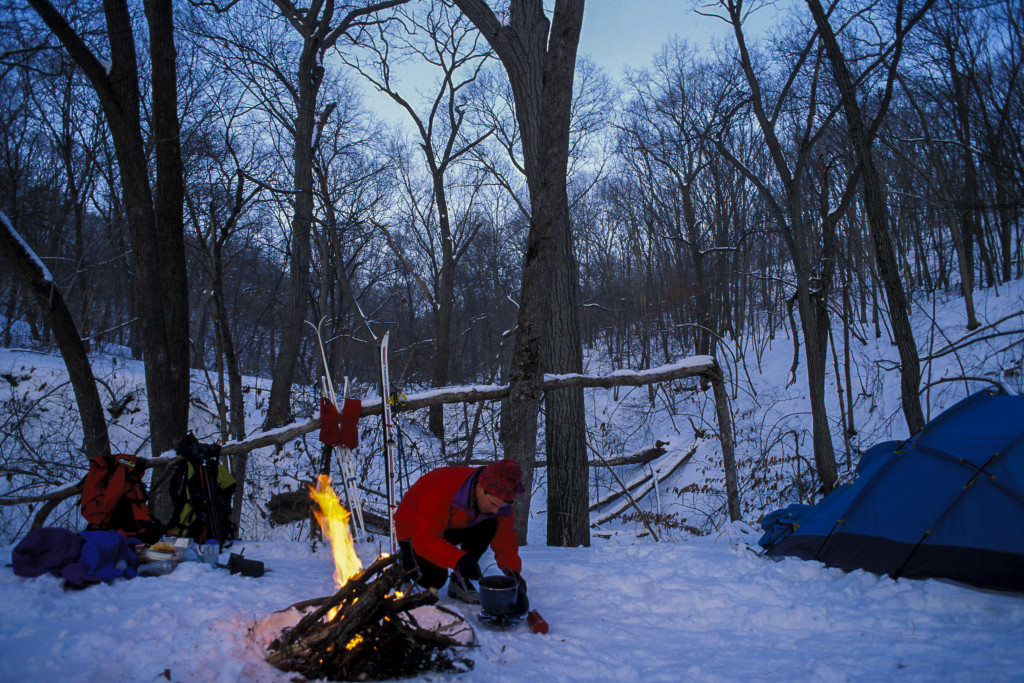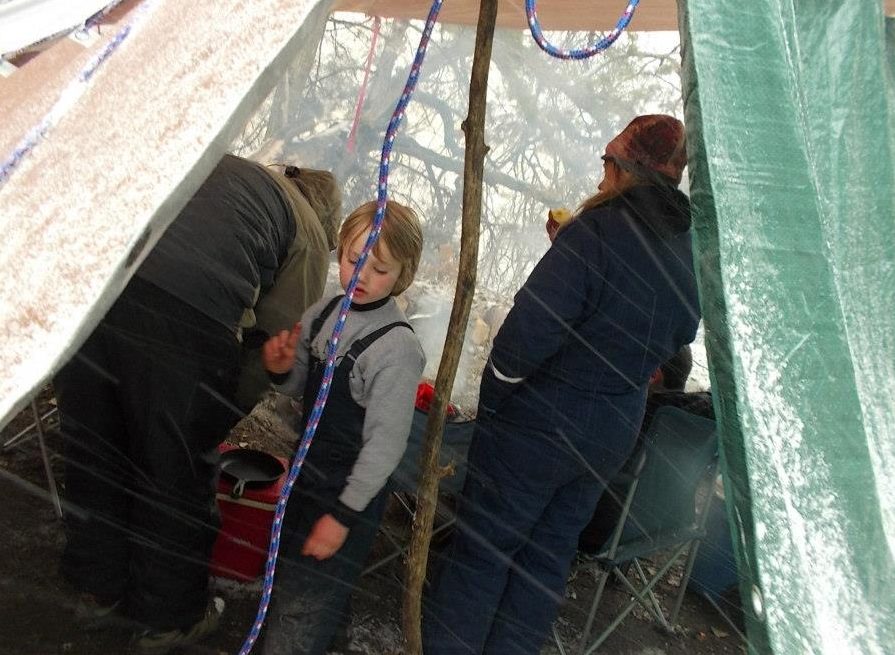
By Jamie Bachmann, Wildlife Educator
In Nebraska, high summer reigns as the busiest season for family camping, but I’m the kind of mom who prefers to camp in seclusion, seeking to avoid the distractions of busy campgrounds. With less than 3 percent of land in Nebraska designated as publicly accessible, opportunities for isolation are limited. But when my kiddos were young, I heard tales — near legends — of families embracing cold-weather camping. Then in March 2003, a single car camping trip to see the sandhill crane migration launched nearly two decades of cold-weather camping.
March in Nebraska can give you beautiful 70-degree weather or ice storms. On that first trip cold-weather camping trip, my oldest was three years old and my youngest was five months and still nursing. Yes, there was a diaper change in the middle of the night when it was below 20 degrees outside. Yes, it was more traumatic for me than the baby. But it was worth it. Although these trips were not always easy and comfortable, they’ve become some of my kids’ favorite and most memorable outdoor experiences. My boys have grown to become resilient because of those experiences.
If you have any interest in expanding your camping season, read on for this mom’s tips in tackling this winter adventure.
The Advantages of Off-Season Camping
Campfire – Thoughts of camping are tied closely to communal fire. However, summer campfires are for cooking and keeping the bugs away only, because hanging out when it’s over 80 degrees in Nebraska humidity is not fun for most. But when it’s 40 degrees, or even colder, the warmth of a fire becomes enjoyable. Also, a campfire that is made for warmth, and not just for summertime ambience, carries a different kind of meaning and significance. A winter campfire teaches you about necessity and thus, highlights the skills required to meet those needs.
I am an advocate for letting kids play with a campfire. How else are they going to learn how to put out a flaming marshmallow without it ending up in someone’s hair? And I have never met a kid who doesn’t want to mess with fire. Gathering wood, kindling and starting a fire are outdoor skills that will be useful for a lifetime. Furthermore, poking at a fire or tossing in pine cones are great ways for children to develop their risk assessment of fire. It’s how they will learn to respect fire.
Less Light – Cold-weather camping also means you are working with sunset near 5 p.m. in December versus 9 p.m. in June. Games under the cloak of darkness, night hikes and listening for nocturnal sounds, are happening way earlier when you are cold-weather camping. Earlier bedtimes are a symptom of camping in the off season as well, because the absence of artificial light allows our internal clock to sync up with natural systems. When camping, my kiddos were always ready to climb into their sleeping bags a couple hours earlier than their regular bedtimes.
Less Insects – Cold weather clears out insects and most people, too. Less people mean less noise and more wildlife viewing opportunities. (However, I would like to take this moment to say I love invertebrates, and I do miss them when they go!)

Gear
When we started cold-weather camping, we simply took our summer gear and extra layers, and then slowly over the years, started upgrading. As any gearhead knows, quality camping gear is expensive, but please, remember that cold weather camping is accessible without having to spend a lot of cash on fancy new gear. Below is a list of gear I suggest for camping in cold weather. Borrow from friends, buy used or just pack more layers until you know you are dedicated to continuing this pastime. I have only recently leveled up my gear.
- Sleeping bags – Sleeping bags have a temperature rating, but be aware that the comfort level for a cold sleeper versus a hot sleeper will be different. If you don’t have the extra cash for a cold-weather bag, line your existing sleeping bag with another blanket and or bag liner to increase the temperature rating.
A tip: The transition from shedding outer layers and hopping into a sleeping bag during cold weather camping can be a tough go for kiddos. A hot water bottle to cuddle with will warm up a bag, but I worried about them leaking. So, I switched to hot rocks! Set the kids out to collect rocks and warm them up by the fire. - Camp Mat – Anything between the sleeping bag and the frozen ground is a must for heat retention. Without this barrier, the cold ground will pull heat from your body, making for a miserable night. Sleeping mats don’t have to be rated for cold weather — use your summer camp mat and an extra blanket to lie on top. Then when your kids get hooked on camping in the cold, you can consider buying better gear.
- Tents – If you have a two- or three-season tent that keeps out the rain, that will work just fine. The most important thing is to keep dry — getting wet is the worst when it’s cold, which can also quickly turn into a more serious situation.
- Layers -Mornings and nights will be cold, but dress your kids in layers that they can peel off if you get a sunny, warm day. Don’t forget about relativity: 45 degrees will seem like a heatwave if night temps were below freezing. Here are a few tips:
- Ears, Fingers and Toes – Cold feet and hands are the quickest way to put out the fire on a good winter adventure. I keep a stock of hand warmers to tuck inside pockets and boots. For those tootsies – toes — make sure to leave enough space for warm air to circulate. The key to keeping ears warm is to assure the wind isn’t sneaking in under a stocking cap. Ear bands will protect from the wind and allow the shedding of hats as kids warm up while running about.
The P’s
There is just no way around it, the inevitable baring of skin for the P’s: pee and poo. Boys may have it a little easier than girls, but we all end up having to squat at some point in time. I don’t have any tips for this other than diaper wipes will always have a place at my camp. We all just suffer through it. Anyone reading have any strategies? I’d love to hear about it.
On a related note, here’s a story about poison ivy: When my youngest was three, we camped in an ice storm, the kind of storm where parts of I-80 were closed. He spent some time taking shelter from the wind in a line of cedar trees, exploring, climbing and jumping off downed trees, all the while covered up in his winter gear. Then a few days after our family adventure, he broke out in poison ivy in the only three places that get exposed in such weather, his hands face and groin.
Urushiol is the compound in poison ivy responsible for the nasty reaction some of us get when exposed. It exists in every part of the plant, even during dormancy and also when dead. If poison ivy is burned, you can suffer a reaction in your lungs by breathing in the fumes. Knowledge is power, and in many cases, will help make outdoor experiences stay pleasant. Know how to identify poison ivy in any season and pass on that knowledge to your children.
If cold-weather camping sounds as though it could scratch an itch for your family, start by planning a couple trips mid- to late fall. Head over to OutdoorNebraska.gov/Parks/Go-Camping and take a look at what Nebraska camping has to offer in the off-season.
